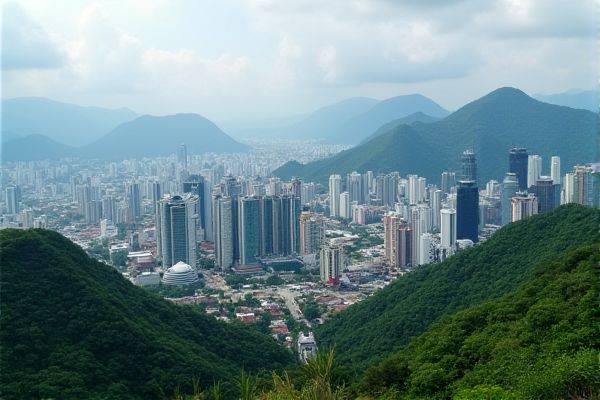
Weather and climate in Malaysia: Hot and humid year-round. Two monsoon seasons. Average temperature: 25-32degC. High humidity levels. Heavy rainfall, especially November-March. Occasional thunderstorms. Tropical climate. Coastal areas cooler. June-August drier months. Variable microclimates within regions.
Hot and humid year-round.
Malaysia has a tropical climate, characterized by hot and humid weather year-round, with temperatures ranging from 73°F to 91°F in the lowlands and coastal areas, and cooler temperatures in the highlands. The country experiences two monsoon seasons, the Northeast Monsoon and the Southwest Monsoon, which bring varying levels of rainfall to different regions. For more detailed information on the climate and weather patterns, you can visit the Weather in Malaysia section on the Intrepid Travel website.
Two monsoon seasons.
Malaysia experiences two monsoon seasons: the Northeast Monsoon from November to March, which brings heavy rains to the eastern side of the peninsula, and the Southwest Monsoon from May to September, affecting the western side with heavy but short-lived downpours, especially in August and between September and October. For more detailed information on the seasonal changes and how they might affect travel plans, Intrepid Travel's comprehensive guide offers insights into the weather in Malaysia to help you plan your trip efficiently.
Average temperature: 25-32°C.
Malaysia's climate is characterized by average temperatures ranging from 25°C to 32°C (77°F to 90°F) throughout the year, with steady temperatures in coastal and lowland areas and cooler temperatures in the highlands. The country experiences high humidity and significant rainfall, influenced by two monsoon seasons. For more detailed information about the country's weather patterns, you can visit the Weather in Malaysia section of the Intrepid Travel website.
High humidity levels.
Malaysia is characterized by high humidity, with average monthly relative humidity ranging from 80% to 90%, varying by location and month. On dry months, the daily minimum humidity can be as low as 42%, while during wet months, it can reach up to 100%. For more information on this topic, please visit the Malaysia Meteorological Department's website.
Heavy rainfall, especially November-March.
Malaysia is expected to experience 20% to 40% more rainfall during the Northeast Monsoon season from November to March. This increased precipitation is likely to bring heavy rainfall to states like Kelantan, Terengganu, Pahang, Johor, Sarawak, and Sabah, potentially leading to flooding. The risk of flooding becomes particularly significant if the heavy rainfall coincides with high tides and low-pressure weather systems. For more detailed information on the impact of the upcoming monsoon season, visit The Edge Malaysia.
Occasional thunderstorms.
Thunderstorms in Malaysia can occur throughout the year but are more frequent during the inter-monsoon periods from April to May and from October to November, typically occurring in the evening and dusk on land and at night over the ocean. For more detailed information, you can visit the Met Malaysia website which provides extensive resources and education on various weather phenomena. Understanding these patterns is crucial for preparing and responding to these natural events effectively.
Tropical climate.
Malaysia experiences a tropical climate characterized by high temperatures and humidity throughout the year, with distinct climate zones including the Tropical Rainforest Climate, Tropical Monsoon Climate, and Tropical Savanna Climate, each with unique seasonal patterns and rainfall distributions.
Coastal areas cooler.
Coastal areas in Malaysia are not cooler; they are characterized by hot, humid weather with average temperatures ranging from 75°F to 90°F (24°C to 32°C) throughout the year. The weather in Malaysia is influenced by the Southwest Monsoon, which brings heavy rains in certain months. For more detailed information on climatic conditions across different regions and seasons in Malaysia, you can explore the insights provided by Intrepid Travel.
June-August drier months.
From June to August, Malaysia experiences its peak tourist season with dry and sunny conditions prevailing throughout the country, making it an ideal time for touring, beach activities, and outdoor explorations. During this time, tourists can relish the vibrant landscapes and rich cultural experiences that the region offers. However, it is essential to note that this is also the period with large crowds and fully booked hotels, making it crucial to plan ahead for any visits. For a comprehensive guide on the best times to experience Malaysia, be sure to check out the Malaysia Seasons Guide for detailed insights.
Variable microclimates within regions.
Malaysia exhibits variable microclimates due to its diverse topography and seasonal wind patterns. For example, the east coast of Peninsular Malaysia experiences heavy rainfall during the northeast monsoon, while inland and mountain-sheltered areas are relatively dry. In Sabah and Sarawak, coastal areas have distinct rainfall maxima and minima, whereas inland areas receive more evenly distributed rainfall. Some regions, like the hill slopes of Sarawak, receive exceptionally high annual rainfall. To learn more about these climate patterns, you can visit the official Malaysia Meteorological Department website.
